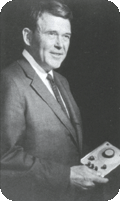Evolution of Sweep Oscillators during the 1960 to 1980 Period
Looking back to the first generation of sweep frequency generator described in the first twenty years of this "Quick Tour," it appears that the technology of this period only allowed the production of single-band, swept microwave sources.
Using Motor-driven klystron oscillators in the very first HP 670X series, then Electronic Swept Backward-Wave-Oscillators in the HP 680 series, by the beginning of the sixties the result was a complete line of single-octave-band instruments covering the full microwave spectra from 1 to 18 GHz. The table-listing below, from the 1961 catalog, recaps all the Electronic Sweep Oscillators of the 680 series.
Specifications-Table for all the 680 series of Sweep Oscillators - From the 1961 Catalog, page 145
Courtesy of the Hewlett-Packard Company |
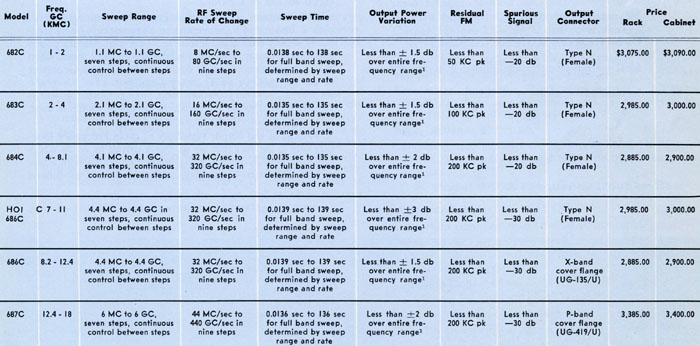 |
A simple calculation from the table above, reflects that a full coverage of the 1 to 18 GHz spectra would cost a microwave laboratory about $20,000 USD in 1961. Other significant values from the 1961 catalog give the following results: One and a half full-rack volume for the six instruments, and a total weight of about 600 lbs. Needless to say that the evolution of the transistor technology during the early sixties was highly welcome.
Short-form Catalog, special WESCON 1966 edition, with introduction of the HP 8690A Microwave Sweep Oscillator
Courtesy of the Hewlett-Packard Company |
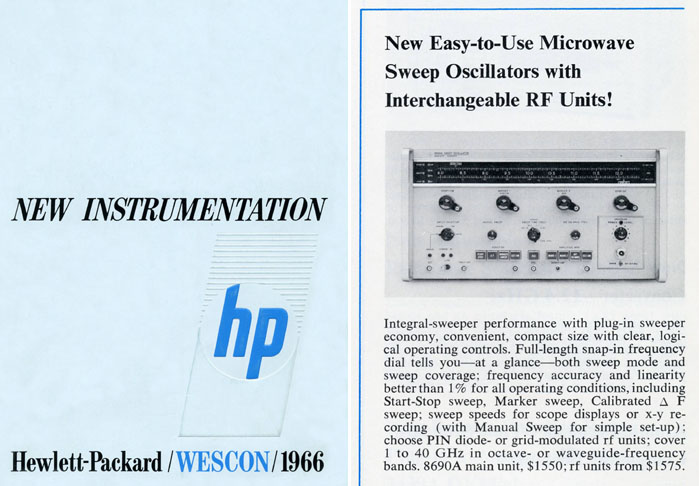 |
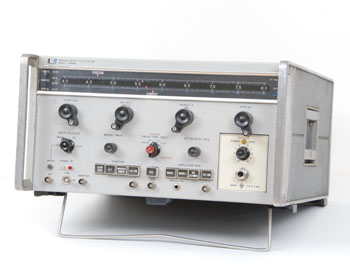 |
The HP 8690A Sweep Oscillator with a 8692A, 2 to 4 GHz Plug-In
|
HP8690A Sweep Oscillator
The Hewlett Packard, first twenty years production of Swept Signal Souces, provided the experience that led to the development of the 8690 series.
The 8690A was introduced at the WESCON 1966 - Hollywood Park, with a complete set of 7 Plug-in units to cover from 1 GHz up to 40 GHz into the microwave frequency spectrum, plus a low frequency band plug-in covering from 100 kHz to 110 MHz.
A short description of the 8690 from the 1967 catalog:
"The Hewlett-Packard 8690A Sweep Oscillator and 8690A/B Series RF Units offer all the advantages of single unit sweep oscillators plus economical multiband capability. The 8698A RF Unit sweeps the range of 100 kHz to 110 MHz with outstanding frequency accuracy and linearity. Complete coverage from 1 to 40 GHz is available with RF units featuring a choice of PIN diode modulation ("B" models), grid modulated BWO units ("A" models), and optional internal leveling.
RF units can be changed quickly and without adjustment. Snap-in scales are keyed for easy changing and accurate positioning. The full width maximum resolution scale and a human engineered layout of the front panel controls allow simple, uncomplicated operation. Ease of operation is enhanced by pushbutton function selection, lighted function indicators adjacent to the scale, presentation of all frequency information which may be read at a glance, and simplified X-Y recorder setup through the use of manual sweep control. Highly accurate, calibrated frequency displays, broad and narrowband sweeps, external FM for frequency sweep programming, CW operation, automatic triggered or manual sweep control plus leveling in all modes of operation combine to give unequaled performance and versatility in a space saving package design.
Four types of RF units are available, permitting selection to meet any application requirement: the Model 8698A low frequency signal generator; the Models 8691-4A/B featuring PIN modulation or grid modulated BWO's and covering the coaxial frequencies from 1 to 12.4 GHz; and the Models 8695-7A for waveguide coverage of the P, K, and R bands. "
Typical Sweep Oscillator Test Bench of the Sixties
HP 8690 Sweeper on the left, Directional Coupler with Detector and Optional Absortive Wavemeter in the center,
HP130C Displaying Oscilloscope on the right |
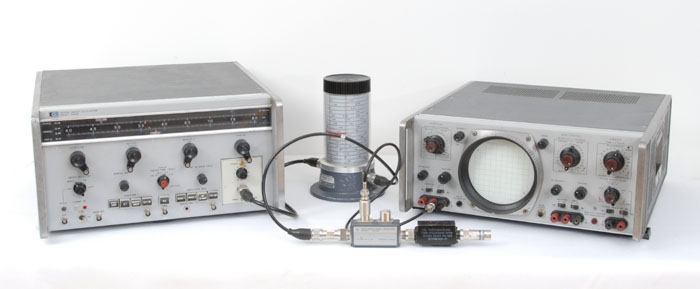 |
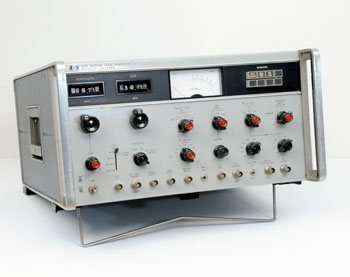 |
The HP 675A Sweeping Signal Generator
|
The HP 675A
Sweeping Signal Generator
The 675A "Sweeping" Signal Generator was introduced in the 1968 catalog and described in the January 1968 issue of the Hewlett Packard Journal.
The 675A was the first of a new kind of sweep generator using a down-conversion technique to achieve a wide single-sweep span at low frequency. Mixing of a variable 100 to 132 MHz signal with a fixed, crystal-controlled 100 MHz signal, results in the 0 to 32 MHz output frequency of the HP 675A with an accuracy approaching that of precision point-by-point plots. To maintain frequency stability with temperature, the entire variable-frequency oscillator was placed in a proportionally-controlled oven.
For the first time, the Model 675A, covering 3 1/2 decades in a single sweep made possible to see the entire frequency response curve of many wideband devices. In checking wideband amplifiers, the wide sweep width reduces the possibility of missing anomalies in the response curve. At the other end, narrow band sweeps were practical due to the very low residual FM of the 675A (less than 70 Hz.) Calibrated delta sweep as low as 1 KHz made possible the measurement of narrow-band crystal filter.
| Detail of the HP 675A Front Panel |
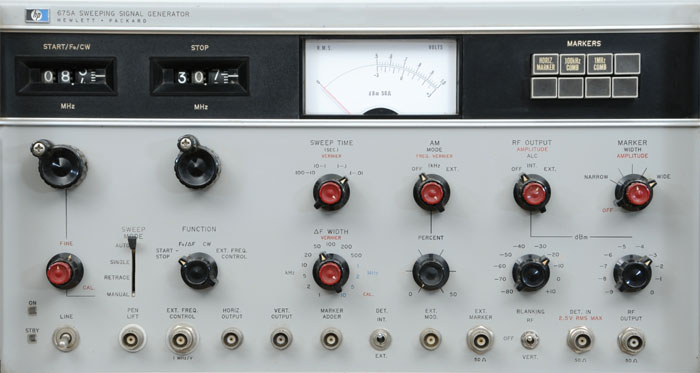 |
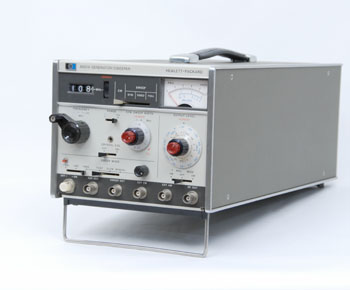 |
HP 8601A Generator - Sweeper
|
The HP 8601A Generator-Sweeper
Already listed in the Signal Generator, previous chapter, the HP 8601A is the immediate successor of the 675A. The 1969 catalog introduces the HP 8601A as a "Two Instruments in One" ultra-versatile broadband source. Covering 100 kHz to 110 MHz, the 8601A Generator / Sweeper combines the high linearity and flatness of a precision sweeper with a signal generator's frequency accuracy and wide range of calibrated power levels.
As a signal generator, the 8601A offers excellent CW characteristics with +/- 1% of frequency dial accuracy and a wide range of continuously adjustable output power levels accurate to +/- 1 dB from +13 to -110 dBm. A power output meter is calibrated in both dBm and rms volts into 50 ohms.
The 8601A uses exactly the same technique as the one which was developed for the 675A. A 200 to 310 MHz Voltage Controled Oscillator ( VCO) mixed with a 200 MHz crystal-controled source for a final, 0 to 110 MHz in one sweep maximum frequency coverage. The main innovation was brought by a VHF frequency discriminator shapping network which help for a perfectly linear frequency sweep of the VCO. This new technology was just made possible by using the very first prescaling integrated circuits available and capable of dividing signals in the VHF range.
The variety of applications opened to the 8601 by the early seventies, made it a prime investment for the basic RF bench. Among the many different uses that could be listed, a Tracking Generator for the 8553B Spectrum Analyzer, and a Swept Signal Source for the 8407A Network Analyzer, were the most important ones and those which contributed to the large diffusion of the 8601A.
Cover of the 1974 Data Sheet for the HP8601A Sweeper
Courtesy of Hewlett Packard Company |
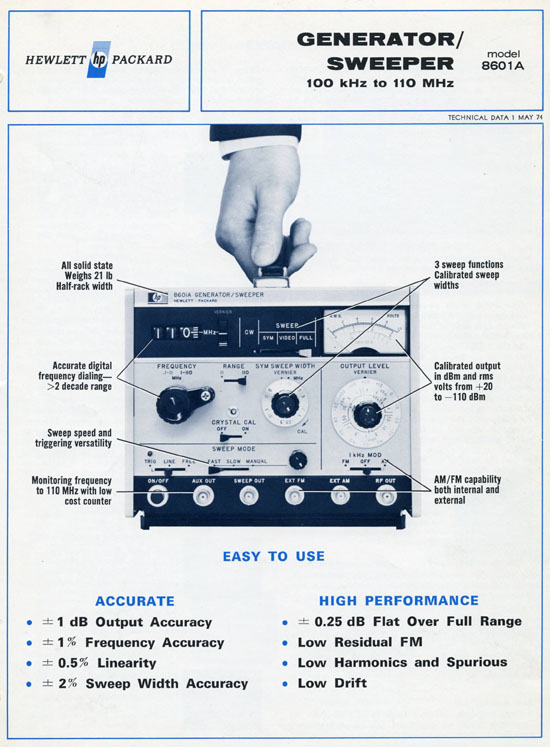 |
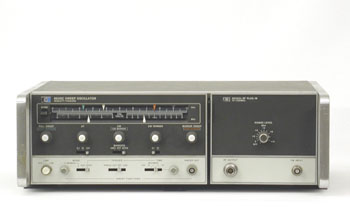 |
The HP 8620C Sweep Generator Mainframe
|
The HP 8620A,
First of a Large Family
The HP8620A "Sweeping" Signal Generator was introduced in the 1971 catalog and described in the November 1970 issue of the Hewlett Packard Journal.
Solid-state design and in-house developed hybrid thin-film microcircuits made possible the multi-octave swept microwave signal generation in a single small-size mainframe.
At its launch in 1971, the 8620A was proposed with a basic RF drawer, Model 8621A which can accept various RF Oscillator Modules to cover 0.1 to 18 GHz in 5 octave bands. Very quickly a quantity of single-band and multi-band plug-in drawers were developed to fit the various needs of frequency coverage, output power, and power leveling, encountered in the microwave laboratory.
The complete collection of plug-ins available in 1972 is listed in the short-form catalog reproduced below.
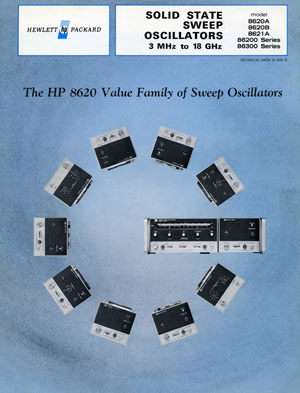 |
Cover of the HP8620 Family, Technical Datasheet, June 1972
Courtesy of the Hewlett-Packard Company
|
The HP 8620 Value Family
of Sweep Oscillators
Short-Form Catalog
A very useful Technical Datasheet edited in 1972 was available to the field engineer and to the customer to help in selecting the best configuration to fit their needs.
HP 8620 Family Technical Datasheet June 1972 ( PDF, 6.6 Mo )
In-depth Look at the HP's Microcircuit technology in the Early 70s
Virtually all the RF circuitry in the HP Model 8620A Microwave Sweep Generator was hybrid thin-film microcircuitry developed and fabricated in house. The frequencies from 0.1 to 4.2 GHz were produced by two RF modules, (8632A & 8633A) which plug into the sweeper RF drawer. An 8 page article in the November 1970 issue of the Hewlett Packard Journal gives an in-depth description of the various microcircuits developed to build these modules. One of these modules, a 0.1-2GHz Frequency Converter, gives us the opportunity to have a spectacular insight into the technological progress of HP Labs in the early 70s.
Inside View of the Frequency Converter Microcircuit
from a 8632A Heterodyne Module (Zoomable)
The HP Journal article reproduced below describes the function of the 5 different hybrid thin-film substrates associated in the converter microcircuit pictured.
When fully zoomed-out, the picture below is 2 times the actual size of the module ( Actual size = 40 x 38 mm ).
|
Use your scrollwheel to zoom in/out
--
Click and drag to view other parts of the image when zoomed |
|
|
|
Frequency Converter Hybrid Microcircuit
|
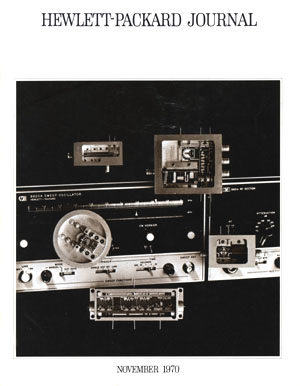 |
Cover of the November 1970 issue
of the Hewlett Packard Journal
Courtesy of the Hewlett-Packard Company
|
Microcircuits
for the Microwave Sweeper
A 8 page article from the November 1970, Hewlett Packard Journal describing the various hybrid thin-film microcircuits developed by HP for the Model 8620A microwave sweeper.
Microcircuits for the Microwave Sweeper ( PDF, 2.7 Mo )
The HP 8620A at work with a 8755A Scalar Analyzer in a 182T Oscilloscope Mainframe
Typical Swept Frequency Test Set of the 70s - Cover of the 8755M/L Data Sheet (May 1975)
Courtesy of Hewlett Packard Company |
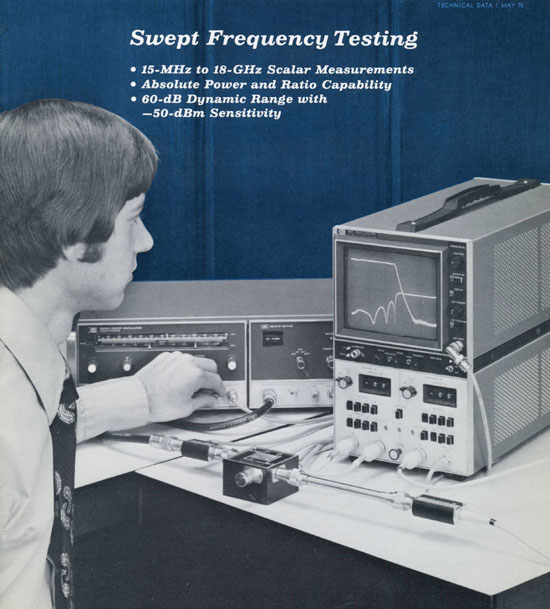 |


